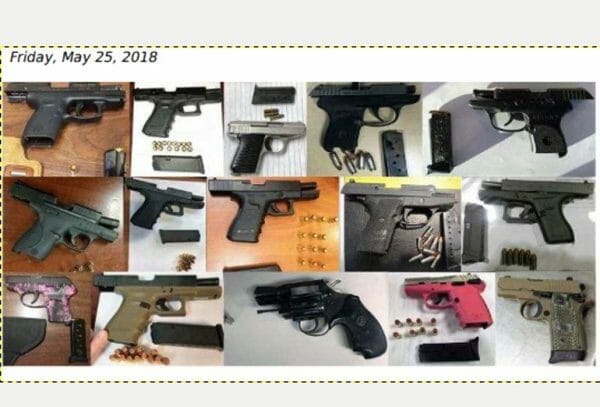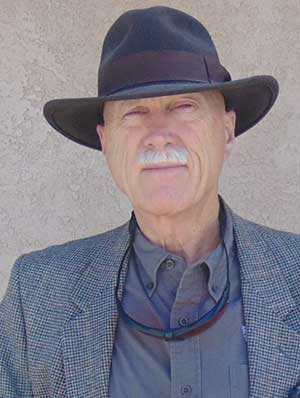
Arizona –-(Ammoland.com)- The collage of pistols discovered by the Transportation Security Administration (TSA) is a small sample of the 84 pistols discovered in carry-on luggage the week of May 7th to May 13th, 2018.
TSA writes the total number of pistols discovered was 84, with 75 holding ammunition, and 29 of those having a round in the chamber. From tsa.gov:
TSA discovered 84 firearms in carry-on bags around the nation last week. Of the 84 firearms discovered, 75 were loaded and 29 had a round chambered. Firearm possession laws vary by state and locality. TSA may impose civil penalties of up to $13,066 per violation per person for prohibited items violations and violations of other TSA regulations. Repeat violations will result in higher penalties. Travelers should familiarize themselves with state and local firearm laws for each point of travel prior to departure. You can go here for more details on how to properly travel with your firearms in checked baggage.
Details of the pistols discovered in carry-on bags (not checked bags) are listed at the TSA page. Most of the pistols have caliber and make noted. As with all data collection, the data has some errors. For example, the data includes a Hi-Point model 22A that had rounds in the magazine, but none in the chamber. The pistol is listed as .22 caliber. I do not believe Hi-Point makes a .22 caliber pistol. Phoenix makes an HP-22A that is chambered for .22 Long Rifle cartridges. Was the pistol a Phoenix HP-22A that a TSA agent mis-labeled a Hi-Point? Maybe. There is a Beretta .38 listed. I do not recall a Beretta .38 being made. Maybe it is a .380, and someone forgot the zero.
In spite of the inevitable errors, a fair amount can be learned from the pistols that were found.
Of the 84 pistols, 78 had make and caliber identified. Assuming the caliber of the 22A was .22 Long Rifle, and the Beretta was a .380, the caliber breakdown was this:
25-.380 caliber; 23-9mm (probably 9X19, or 9mm Luger); 11-.40 caliber; 5-.38 (probably revolvers), 5-.22 rimfires; 3-.357 (revolvers); 2-.45 caliber, 2-.32 caliber (one a Colt revolver) and 2-.25 caliber pistols (both Ravens!).
Most people discovered carrying pistols in their carry-on luggage had chosen good quality guns. There were 19 Glocks, 17 Rugers, 15 Smith & Wessons, 5 Taurus, 4 Sig Sauer, 3 Kel-Tecs, a couple of Kimbers and Springfields, a Walther, and a Colt. There was a smattering of inexpensive pistols such as Bryco, Raven, a Cobra .22 Derringer and the possible Phoenix. Those were only five of the total.
One of the .22 pistols was a North American Arms mini-revolver.
Almost all of the pistols were simply forgotten. People get busy. A family member puts a pistol back in Mom’s purse. A busy executive’s intention to take the pistol out is thwarted when a minor emergency interrupts the thought process at a critical point.
None of us is perfect. With over 770 million passengers being checked through TSA checkpoints last year, less than 4,000 forgot or misplaced a pistol in their carry-on.
I once carried a full box of .22 ammunition in my computer case, to a conference. When I discovered it, it did not make the return trip. Do things often enough, and mistakes will be made.
It has been reported that in undercover tests of the TSA system, weapons or explosives were missed over 90% of the time.
That rate likely does not apply to people who made mistakes. They were not attempting to sneak items through the system.
To put the figures in perspective, only about 1 in 192,000 people make this error in a given year. It is as if one person went through the system each day for 500 years, and only screwed up once.
Everyone makes mistakes.
©2018 by Dean Weingarten: Permission to share is granted when this notice is included.
About Dean Weingarten:
Dean Weingarten has been a peace officer, a military officer, was on the University of Wisconsin Pistol Team for four years, and was first certified to teach firearms safety in 1973. He taught the Arizona concealed carry course for fifteen years until the goal of constitutional carry was attained. He has degrees in meteorology and mining engineering, and recently retired from the Department of Defense after a 30 year career in Army Research, Development, Testing, and Evaluation.
